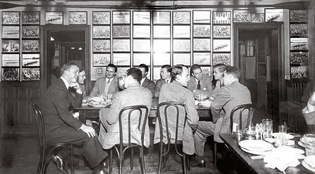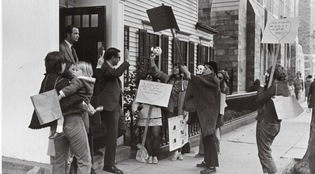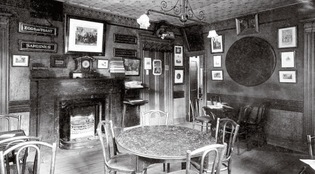 loading
loading
Will Mory's survive? (And should it?) Collection of Richard Nash Gould '68The Whiffenpoofs, pictured here in 1940, have a customary table inscribed with each group's initials. View full imageWith the increased dues in place to provide a financial cushion, Mory's is proceeding this fall with a number of innovations recommended by consultants to try to regain the club's share of the Yale community's discretionary income. "A lot of our support in the past has come from people who feel very strongly about keeping Mory's Mory's," says Tyler, "and that's one of the reasons we were slow to react. But we know that there have to be some significant changes." As this article went to press, Shumway was still experimenting with dishes for a revamped menu. He wasn't able to say what new dishes might be offered (though he did mention wasabi tuna as a possibility). But he was quick to offer reassurance to diehards: "There will be rarebits, there will be baker's soup, and there will be liver and lamb chops and all the Mory's favorites. But we can't just have club food. We have to be in the mainstream." The club is also going to start staying open until midnight on Thursdays, Fridays, and Saturdays. After nine, Shumway says, the club will serve drinks and a cheaper, more student-oriented menu, perhaps with burgers, chicken wings, and the like. Perhaps more surprising, the building was recently fitted for wi-fi service, and laptop computers may soon be permitted in the upstairs rooms. Further down the line, Mory's is looking to make significant changes to its home. The early-nineteenth-century building needs a lot of work to update its mechanical systems, and the board has discussed installing a bar and adding conference space upstairs. All this would require a strategic plan and a capital campaign, Tyler says, which will have to wait "until we put the ship on an even keel." Aside from these changes, when I talked to people associated with Mory's about how they're addressing their woes, they spent a surprising amount of time talking about the pictures on the walls. More than one mentioned the fact that they recently began hanging pictures of women's athletic teams in addition to men's, and Shumway suggested that they might branch out more in their choices -- he has begun to add singing group photos, and he suggests including pictures from the Political Union (another loyal constituency) and perhaps portraits of Yale Rhodes Scholars. "We may need to reflect more of the richness that is Yale on our walls than we do today," says Shumway. Such attention to what's on the walls may seem like rearranging the picture frames on the Titanic, but the importance attached to it goes to Tyler's characterization of Mory's as a "museum of the evocative." Mory's is slowly realizing that the Yale it is evoking is at best foreign and at worst off-putting to many in the Yale community today. Richter Elser ’81, a Mory's member who has operated restaurants in New Haven and is now general manager of the Quinnipiac Club, says Mory's "has to figure out which constituency it's going to cater to. If it's students, that takes you toward late-night food. If it's Yale faculty and administrators, that suggests an emphasis on better and quicker dining at lunch time. And if it's alumni, their interests are more directed toward early evening dining. So my concern is that if they try to do all three at the same time, it's difficult to do any one of them well." And the club's most cherished goal may also be the most elusive, says Elser. "For Mory's to be Mory's, they really have to reconnect with the student body. But trying to reach the undergraduates is probably the toughest, because they have to win them back. The Yale Co-op, in its last couple of years, was trying all sorts of things to be a new and reinvented retailer, but none of them really took off. Ultimately it became part of Yale's history instead of something necessary on Broadway."  Manuscripts and ArchivesMory's was picketed in 1970 over its refusal to admit women. View full imageIt's tempting to speculate that Mory's won't outlive its current aging clientele, that the club's air of WASP privilege will make even less sense to future, more-diverse generations of students and faculty. But it's not necessarily true: students from all backgrounds have come to Yale and learned to love faux Gothic architecture, the Elizabethan Club, a cappella singing, and other seemingly arcane traditions. And many of them love Mory's, too. Moshe Sarfaty ’08, who came to Yale from Israel at the age of 21 after serving in the Israeli Army, first went to the club as a freshman for a squash banquet. "I said to myself, 'This is why I came to Yale—the tradition, the history, all in one place.'" Sarfaty, who is now working in investment banking in New York, has continued his membership. "In my four years at Yale, the only time I ever had tears in my eyes was in Mory's, when I was elected captain of the squash team. That was one of the most meaningful moments in my life. So this is why I'll do everything I can to help and support Mory's."  Manuscripts and ArchivesWhen Mory's moved to its current home in 1912, tables, a mantelpiece, light fixtures, and signs were brought over from the old location on Temple Street, pictured here in 1900. View full image
The comment period has expired.
|
|